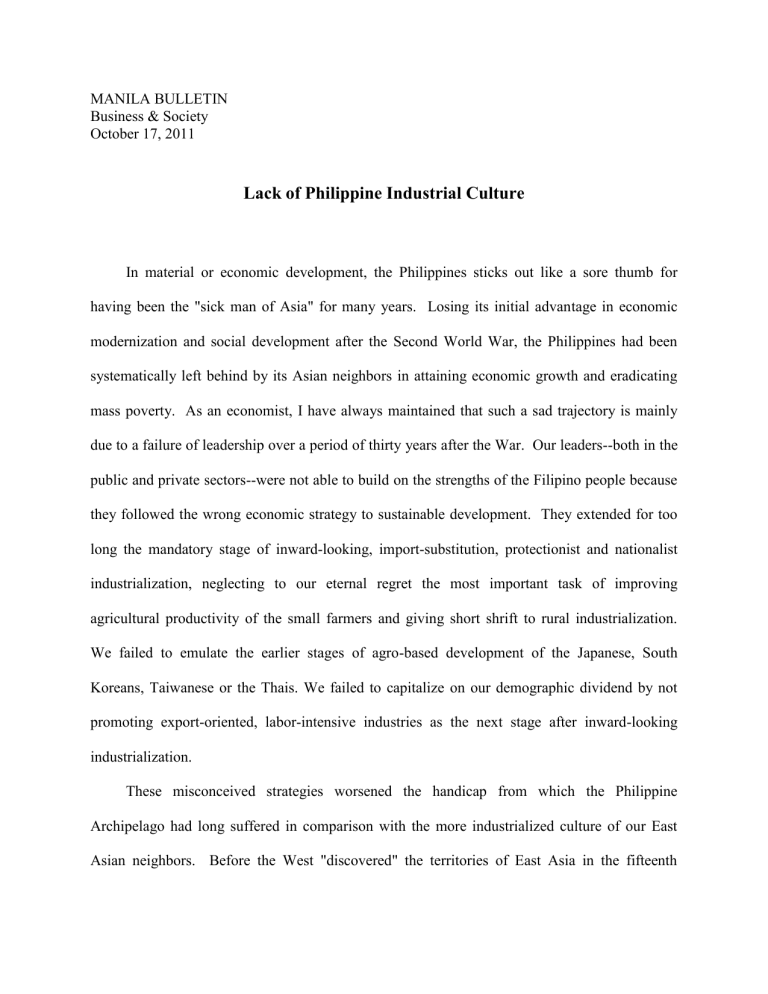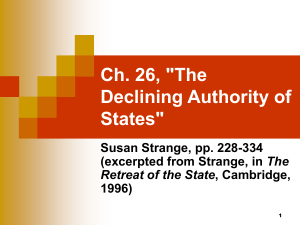Lack of Philippine Industrial Culture

MANILA BULLETIN
Business & Society
October 17, 2011
Lack of Philippine Industrial Culture
In material or economic development, the Philippines sticks out like a sore thumb for having been the "sick man of Asia" for many years. Losing its initial advantage in economic modernization and social development after the Second World War, the Philippines had been systematically left behind by its Asian neighbors in attaining economic growth and eradicating mass poverty. As an economist, I have always maintained that such a sad trajectory is mainly due to a failure of leadership over a period of thirty years after the War. Our leaders--both in the public and private sectors--were not able to build on the strengths of the Filipino people because they followed the wrong economic strategy to sustainable development. They extended for too long the mandatory stage of inward-looking, import-substitution, protectionist and nationalist industrialization, neglecting to our eternal regret the most important task of improving agricultural productivity of the small farmers and giving short shrift to rural industrialization.
We failed to emulate the earlier stages of agro-based development of the Japanese, South
Koreans, Taiwanese or the Thais. We failed to capitalize on our demographic dividend by not promoting export-oriented, labor-intensive industries as the next stage after inward-looking industrialization.
These misconceived strategies worsened the handicap from which the Philippine
Archipelago had long suffered in comparison with the more industrialized culture of our East
Asian neighbors. Before the West "discovered" the territories of East Asia in the fifteenth
2 century, the people inhabiting our islands had the most backward technology. While our neighbors, especially China, already surpassed the West in technology before the 18th century, our pre-Spanish ancestors knew nothing of the wheel; the plow; the construction of road and bridges; new crops like corn, tabacco, camote, coffee, tea, cacao, beans, achuete, onion, potato, guava, papaya, pineapple, squash, lettuce, etc; livestock like horses, cows, sheep, turkeys, geese , etc. We had the carabao but we did know how to use it as a work animal until the Spaniards came. We were ignorant of the factory system; paper and printing; the calendar and clock; the map and the charting of the Philippine shape; the arts of painting and architecture; the technique of cooking called the guisado or saute; and the bell. As eloquently described by arguably the best Filipino writer of the last century, Nick Joaquin, in his book Culture and History , these technological contributions to our society came only with our contact with the West in the sixteenth century. Our Asian neighbors had most of these technologies but they never deigned to transfer these to our shores. As the Indians were building their majestic Taj Mahal, the Javanese their imposing Borobudur temple, the Indochinese their magnificent Angkor Wat, and the
Chinese their unparalleled Great Wall, we were still living in houses on stilts or made of nipa and bamboo. When we exhibit in our museums ceramics and porcelain, they are always of Chinese origin. We can only show the primitive earthen jars of our pre-Spanish ancestors.
Our national pride will make it hard to swallow the following very objective observation of
Nick Joaquin: "If the West had not come, and if the local push of Islam had continued to slow down, and if Asia had remained as indifferent as ever, then we would be today, much like the
Papuans and Samoans, a small Pacific pocket of paganism, with various Muslim city-states on the coasts, various river kingdoms in the interior, various clan turfs in the hills, and all these groupings as unaware, say as the Ilongot is to this day of the Zambal or of anything beyond his
3 tribal frontiers." And to thoroughly embarrass some of our nationalists who still boast of our
"glorious pre-Spanish civilization", Joaquin adds: ""The Philippine condition in pre-West Asia can thus be summed up in two words: unknown and unknowing; while the attitude of our neighbors to us can likewise be summed up in two words: ignorant and indifferent... Certainly, with the Spanish epoch, what a change in Asian attitudes towards us! Suddenly we are no longer terra incognita. Suddenly this land fit only for snakes and savages becomes, for the Chinese and
Japanese, a good place to visit, to settle in, even to covet. Suddenly this land so ignored by
Asian progress finds its neighbors come crowding with their produce and manufacture, for the galleon trade dealt not only in Chinese silks but with the entire gamut of Asian commodity, from the stuffs of jewels of India and Cambodia to the pearls and herbs of Japan and the Indies; and
Manila, which gathers in all this wealth of the East for export to the world, becomes as the port of Asia, an Asian city at last."
Unfortunately, the first technological transformation introduced during the Spanish era hardly advanced during the American colonization period because of the free trade policy adopted by the American colonizers. Technological dualism resulted from the emphasis on the export of plantation products like sugar, hemp and coconut to the U.S. market while the
Philippines was completely a free-for-all for very cheap American manufactured products. We failed the first step of an industrial revolution, which is a green revolution in the production of rice, corn, vegetables, fruits, livestock, and other higher-value crops for the domestic market.
The vast majority of our farmers who constituted more than 80 percent of the population during that time continued to use very primitive technology. They were not provided with the efficient rural infrastructures that are indispensable for a thorough-going agricultural revolution. The result was mass poverty in the rural areas. Today, very little has changed.
4
This state of affairs was not reversed during the post-independence period. An industrial culture and a productivity consciousness failed to take root because of the emphasis on very capital-intensive, import-substituting and highly protected industries that employed very few local workers. Very limited industrial training was being given to those who worked for these inward-looking industries because they were adding very little value to the semi-processed raw materials that were being imported. As the colorful late Mayor of Manila, Arsenio Lacson, called them, they were "beauty parlor" industries because they were typified by the corrugated iron factories that imported the manufactured steel and just subjected them to a "curling" process.
As mentioned above, the alternative strategy could have been the early introduction of exportoriented, labor intensive industries that introduced many more local workers to a factory culture, as the South Korean and Taiwanese did in the last century.
The worse feature of the post-independence economic strategy was the continuation of technological dualism in the agricultural sector. Side by side with the relatively more modern export-oriented plantation sector like sugar and pineapple, there persisted an agrarian world that was not very far from the "carabao" technology introduced by the Spaniards in the sixteenth century. Governments after governments were grossly guilty of the sin of omission by neglecting to endow the poor small farmers with farm-to-market roads, irrigation systems, postharvest facilities and other infrastructures that embody the industrial culture as applied to agriculture. It must be recalled time and time again that "industry" does not apply only to pure manufacturing. Industry also includes construction and infrastructure, mining, transport and communication, and public utilities. We miserably failed to "industrialize" the farming sector.
Since compared to our neighboring countries, both in Northeast and Southeast Asia, we started with the serious handicap of a lack of an industrial culture, we have to exert much more
5 effort to accelerate the technological education of our working population. We must give more importance to engineering and science education. We must equip many of our young people with electro-mechanical, mechanical, chemical, agronomical and other technical skills in nonuniversity educational programs such as those provided by the Meralco Foundation, Dualtech,
CITE, the Don Bosco schools and other TESDA-certified vocational schools. A larger part of the national budget must be allocated to research and development in adapting technology borrowed from abroad to local circumstances. We must make sure that those manufacturing activities such as food and beverage, garments, electronics, automotive parts, furniture, and other employment-generating industries receive government assistance through fiscal and other nontariff incentives to be globally competitive. Another most efficient way of accelerating the creation of an industrial culture among our population is greater openness to Foreign Direct
Investments, which has been demonstrated by our experiences during the Spanish era as an effective means of technological and scientific advancement. FDIs are a channel for borrowing and adapting technology from abroad. We need not reinvent the wheel which in fact was brought by the Europeans to our shores. For comments, my email address is bernardo.villegas@uap.asia
.
6




